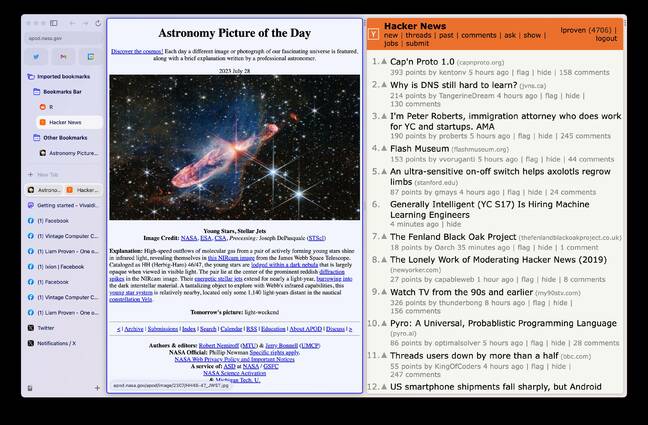Arc: A radical fresh take on the web browser
In an industry that runs on hype, this might just live up to it
Arc is a new Chromium-based web browser which shakes up the standard workflow that browsers have had ever since tabs were invented. It's good, but it will take some getting used to.
The browser is based on the Chromium engine, and comes from a startup which modestly calls itself the Browser Company of New York. Arc isn't open source, or at least not yet, and the current version only runs on Apple macOS – specifically on macOS 12 or later – and iOS. A Windows version is under development, in the same Swift programming language that the Apple versions were built in.
Development does seem to be rapid: Version 1.0 only became available to the public earlier this week, and it has already been updated to 1.1.
It is an unusual and ambitious project that seeks to defy a number of conventions in existing web browsers.

Arc 1.1 with two visible tiles and a whole bunch of tabs, automatically grouped to highlight which are from bookmarks and which are newly-opened and disposable. - Click to enlarge
The basic inspiration seems to be that a lot of people today essentially live inside their web browser for more or less all the time that they're using their computer. So Arc attempts to bring together some of the concepts from modern desktop OS designs and implement them within the web browser.
So, while a number of web browsers offer vertical tab bars, Arc only offers one – but a significantly more powerful version than we've seen in any rival product. Arc's sidebar contains at least three different functions, all integrated into one, and it also attempts to automatically manage your tabs for you. As such, the company has invented some of its own terminology, which might irritate you, but we recommend sticking with it.
The sidebar contains a mixture of "favorites", which in other browsers would be called pinned tabs, and which are always open; bookmarks; and, down at the bottom, the currently open tabs. If you are used to the very simplistic tab management of most existing browsers, such as Chrome, Safari, or un-augmented Firefox, this might sound confusing or off-putting, but speaking from personal experience it really can work.
The reason that we say this of a brand-new browser is that, as it happens, it is very similar to the arrangement which The Register FOSS Desk used for many years in Firefox, thanks to an artful combination of extensions. However, when Firefox introduced its Quantum version, XUL Extensions were no longer supported, and all that went away.
For a while, it remained possible in the Waterfox Classic fork of pre-Quantum Firefox, but today, sadly, that browser is barely usable anymore. The prospect of getting some of this functionality back again is why we wanted to look at this new browser.
However, Arc offers more than just a sophisticated combination of tab and bookmark handling. It also integrates some intelligent, semi-automated window management into a single browser window.
Two examples of this are that it implements a sort of tiling window manager for webpages, so that you can have multiple different web pages side-by-side, or above one another, in a single window. It can also open one website as a temporary pop-up box on top of the current one that you are working in, a feature which we already find rather handy.
Along with lots of keyboard controls, it also has a sort of command line interface. Rather than opening a new tab, the Cmd+T keystroke instead opens a rudimentary command line, from which you can control the browser itself with keywords, or enter URLs, or input search terms.
We found this a little disorienting at first, and felt concerned that whatever we were searching for was going to replace the page that we were currently looking at — but it proved smarter than that and the system actually works well.
As we said, we used to enjoy a much simpler version of this within Firefox, before Mozilla decided to throw away 20 years of development of add-ons and extensions.
To be honest, we would have been perfectly happy if we just got our old combined sidebar back again — but then again, this vulture normally operates with at least two different web browsers open on two separate monitors all the time anyway. We are a different sort of power user to the type of customer that Arc is aiming at.

Vintage stuff: just for comparison, this is Waterfox Classic, with a hand-crafted merged sidebar using three different XUL extensions. - Click to enlarge
Presumably, the idea is that users will run it full-screen. We can certainly see the use of that with its tiling functionality, both on a small screen such as a MacBook, or on a single, very large screen attached to a desktop Mac.
Tiling window managers are old news now in the Linux world, and therefore a product like this might make less of a splash in that market. We also have to grudgingly admit that Windows 11's tiling functionality is significantly improved over the Aero Snap system that's been available since Windows 7 or thereabouts.
iPadOS does include limited tiling of just two windows at a time, but desktop macOS does not, unless you had a package such as Rectangle or Moom. Instead, it has Stage Manager, which is not the same thing but is loosely analogous.
- Waterfox: A Firefox fork that could teach Mozilla a lesson
- Apple demands app makers explain use of sensitive APIs
- Google's browser security plan slammed as dangerous, terrible, DRM for websites
- Google's next big idea for browser security looks like another freedom grab to some
It also has to be said that there are some other innovative web browsers out there — in particular, we are thinking of the power-user functions in Vivaldi here. Vivaldi has a different sort of approach though: it's trying to add in additional sophisticated features, functions, and tools for people who are already browser power users.
For many years, Mozilla was the power users' web browser in this sort of sense, and we really wish that the company was still as innovative as Vivaldi is today. We could be wrong, but we don't get the same feeling that either outfit is trying to reinvent how people use a web browser.
The Browser Company does seem to be, and as such, we think that it chose to launch on the most appropriate platform. We're not totally sold on Arc yet, but it certainly has impressive potential, and it can already do things that no other modern browser can.
We're going to give it a little bit more time and see if we can get used to the new UI features. If you are a Mac user and a very heavy web user, we suggest that Arc is worth a look. ®
 Biting the hand that feeds IT
Biting the hand that feeds IT